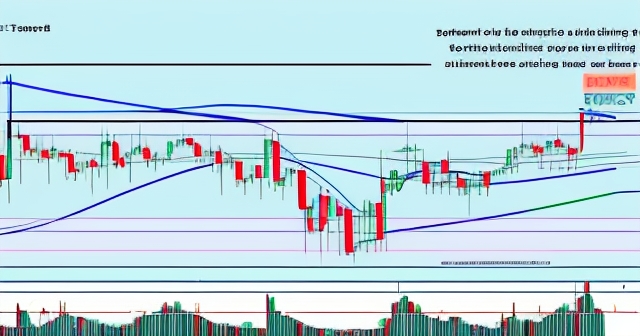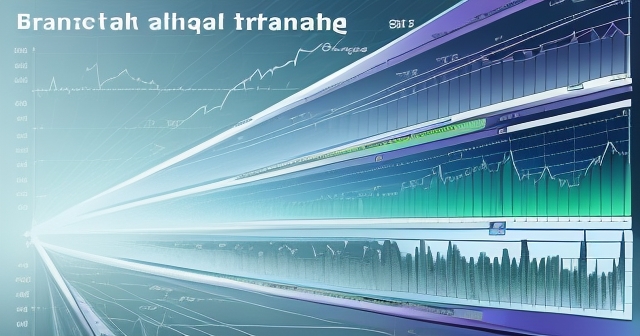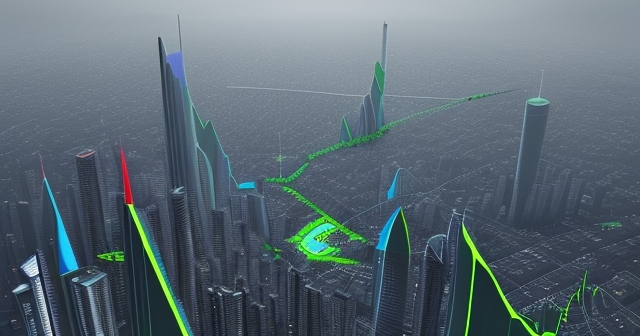Decoding the Rising Wedge Pattern: A Technical Signal for Bearish Reversals
Welcome to our exploration of technical analysis, where we delve into the visual language of price charts. Today, we’re focusing on a specific pattern that often captures the attention of experienced traders: the Rising Wedge pattern. Understanding this formation can provide you with valuable insights into potential market turning points, particularly signaling possible downward movements after an upward trend. As you navigate the markets, whether you are just beginning your journey or refining your existing strategies, recognizing and interpreting these chart patterns becomes an indispensable skill.
Technical analysis isn’t about predicting the future with certainty; rather, it’s about identifying probabilities based on historical price action and trader psychology. The Rising Wedge pattern is one such probabilistic tool. It’s a pattern characterized by a tightening price range, contained within converging upward-sloping trendlines. While it might seem counterintuitive for an upward-sloping pattern to signal a potential decline, its structure and the typical accompanying volume behavior tell a different story about the underlying market dynamics. Let’s break down what makes this pattern so significant and how you can potentially use it in your trading.

What is a Rising Wedge Pattern?
At its core, the Rising Wedge pattern is a technical chart pattern observed when price action is constrained between two trendlines that are both sloping upwards but are drawing closer together, or converging. Think of it like a funnel or a cone that’s tilted upwards. The key visual characteristic is this convergence of the support and resistance lines as price moves higher.
- Typically, the pattern forms over a period ranging from a few weeks to several months.
- You’ll see prices making higher highs and higher lows, consistent with an uptrend.
- The rate at which these highs and lows are increasing is slowing down.
During this time, you’ll see prices making higher highs and higher lows, consistent with an uptrend, but the rate at which these highs and lows are increasing is slowing down. The upper trendline connects the successive higher highs, while the lower trendline connects the successive higher lows. It’s crucial to note that the lower support trendline usually has a steeper slope than the upper resistance trendline. This difference in slope is a key identifier of the rising wedge, setting it apart from other wedge patterns or channels.

Anatomy: Drawing the Rising Wedge Trendlines
Drawing the trendlines for a Rising Wedge pattern requires patience and precision. You need at least two points to draw a line, but confirmation of a valid trendline usually requires three or more touches. For the Rising Wedge:
- The upper trendline acts as resistance. You draw it by connecting at least two, ideally three or more, swing highs. These highs should be successively higher, but the line should not be as steep as the lower trendline.
- The lower trendline acts as support. You draw it by connecting at least two, ideally three or more, swing lows. These lows should also be successively higher, but this line should be noticeably steeper than the upper resistance line.
As you connect these points, you’ll observe the two lines angling upwards but undeniably converging towards a point on the right side of the chart. The price action bounces between these two converging lines, creating the wedge shape. The narrowing range between the trendlines is a visual representation of decreasing volatility and, often, weakening conviction among buyers as the pattern matures.

Why the Rising Wedge is Typically Bearish
While the price is moving upwards within the rising wedge, the pattern is overwhelmingly considered a bearish signal. Why is an upward-sloping pattern forecasting a potential downward movement? The psychology behind the pattern provides the answer. The pattern forms as bulls (buyers) are managing to push prices higher, creating higher highs and higher lows. However, the rate of ascent is slowing down, indicated by the converging trendlines. The rallies to new highs are becoming weaker or occurring with less conviction (represented by the upper, flatter trendline), while pullbacks are finding support at successively higher levels, but the slope of this support line is steeper (the lower trendline).
This discrepancy in slopes is critical. It suggests that while buyers are still present and supporting the price at higher levels (steeper support), they are failing to sustain the strong upward momentum needed to create significantly higher highs (flatter resistance). It implies that supply (selling pressure) is beginning to match or even slightly outweigh demand (buying pressure) as the price moves higher within the narrowing range. The market is struggling to extend its gains, signaling potential exhaustion of the preceding uptrend. The narrowing range itself reflects increasing indecision and decreasing volatility, often a precursor to a significant move. When the price eventually breaks out of this confined space, the direction of the breakout is highly anticipated, and in the case of a rising wedge, the anticipated direction is downwards, confirming the bearish reversal outlook.

Volume Analysis and the Rising Wedge
Confirmation from trading volume is a crucial aspect when analyzing any chart pattern, and it’s particularly significant with the Rising Wedge. A classic, reliable Rising Wedge pattern is often accompanied by decreasing trading volume as the pattern develops. Imagine the price slowly grinding higher within the wedge, but with less and less enthusiasm from traders, as indicated by the falling volume.
This decline in volume while price is rising within the wedge further supports the interpretation of weakening buying pressure and increasing indecision. It suggests that the upward movement is not being supported by broad participation from market players. When the price finally breaks below the lower trendline, you would ideally see a sudden surge or expansion in volume. This increase in volume on the downside breakout adds considerable weight to the bearish signal, indicating strong selling pressure entering the market and potentially initiating a sustained downtrend. If a downside breakout occurs on low volume, it could be a less convincing signal or even a potential false breakout.
Trading the Bearish Rising Wedge: A Step-by-Step Guide
Trading the Rising Wedge pattern involves a systematic approach, focusing on identifying the pattern, confirming the signal, and managing your risk. Here’s a general framework for how you might approach trading a potential bearish rising wedge:
- Identification: First, you need to spot the pattern on your chart. Look for price action contained within two converging, upward-sloping trendlines. Ensure the lower trendline is steeper than the upper one. The pattern should ideally form after a noticeable uptrend if you’re looking for a bearish reversal.
- Validation within the Pattern: While the pattern is forming, observe the volume. Ideally, volume should be decreasing as the price moves higher within the wedge. Count the touches: ensure you have at least two, preferably three or more, valid touches on each trendline.
- Waiting for Confirmation: Do not trade the pattern before the breakout occurs. The bearish signal is only confirmed when the price decisively breaks below the lower trendline of the wedge.
- Entry Point: Once the downside breakout is confirmed, you can look for an entry, typically initiating a short position. The entry might be placed just below the broken lower trendline, or you might wait for a subsequent pullback to the underside of the broken trendline which then acts as resistance.
- Stop Loss Placement: Protecting your capital is paramount. A common strategy is to place your stop loss order just above the highest point reached within the wedge pattern. This level represents the point at which the bearish premise would be invalidated. Alternatively, you could place the stop loss just above the upper trendline at the point of breakout.
- Price Target Calculation: There are different methods for setting a potential price target. The most common is the “measured move” method. You measure the widest part of the wedge (the distance between the two trendlines at the beginning of the pattern) and project that distance downwards from the point of the breakout. Other traders might use previous support levels, Fibonacci retracement levels, or other technical indicators to determine targets.
Remember, this is a general guide, and specific strategies can vary based on your trading style, risk tolerance, and the specific asset you are trading. Always backtest any strategy and consider paper trading it before using real capital.
If you’re considering trading different financial instruments, including currencies often subject to technical analysis patterns like this, finding a platform that offers a wide range of options and robust tools is important.
If you’re considering beginning forex trading or exploring more CFD products, then Moneta Markets is a platform worth considering. It originates from Australia and offers over 1000 financial products, making it suitable for both novice and professional traders.
Confirmation is Key: Waiting for the Breakout
Let’s reiterate the importance of confirmation. The upward-sloping nature of the rising wedge can be deceptive. Until the price actually breaks decisively below the lower trendline, the pattern remains just a potential setup. A premature entry can lead to significant losses if the pattern fails to play out as expected and price continues to move higher.
How do you confirm a breakout? A widely accepted method is to wait for a candle to close convincingly below the lower trendline on your chosen timeframe (e.g., hourly, daily, weekly). A quick dip below the line followed by a close back inside the wedge is often considered a false breakout or “shakeout,” designed to trap traders who entered too early. Looking for strong momentum on the breakout candle or confirmation from increasing volume on the breakout can further validate the move. Some traders also prefer to see a retest of the broken trendline from below before entering, offering a potentially safer, albeit sometimes missed, entry point.
Setting Entry, Stop Loss, and Price Targets
Let’s expand a bit on the practicalities of managing a trade based on a Rising Wedge breakout. Your entry point is crucial. Entering immediately upon the candle close below the lower trendline is one approach, suitable for aggressive traders. A more conservative approach involves waiting for a brief pullback to the broken trendline – now acting as resistance – before entering. This provides higher conviction if the retest is rejected but carries the risk that price may not retest and simply continue its descent.
Setting the stop loss is non-negotiable for risk management. As mentioned, placing the stop loss above the highest swing high within the pattern is a logical choice, as a move above this level invalidates the bearish structure. A tighter stop could be placed just above the upper trendline at the point of the breakout, though this increases the risk of being stopped out prematurely on a minor fluctuation. The stop loss defines your maximum potential loss if the trade goes against you.
Calculating a price target provides a goal for your trade. The measured move is a standard technique: take the vertical distance between the upper and lower trendlines at the widest point (usually the beginning of the pattern) and subtract this distance from the breakout point. For example, if the wedge is $10 wide at its base and the price breaks out at $50, a potential target would be $40 ($50 – $10). Other targets could be based on previous significant support levels on the chart, or you could use tools like Fibonacci Retracement Levels applied to the prior uptrend or the movement within the wedge itself to identify potential support areas where price might bounce or consolidate. Using multiple methods can help you identify a range of potential targets.
The Rising Wedge as a Continuation Pattern
While predominantly known as a bearish reversal signal that forms at the end of an uptrend, the Rising Wedge can, less commonly, appear as a continuation pattern. This occurs when the Rising Wedge forms during a downtrend. In this scenario, the pattern represents a temporary, corrective bounce or consolidation within the prevailing downward movement.
Imagine a market that has been falling. Price then enters a period where it drifts upwards, forming the characteristic converging, upward-sloping wedge. This upward movement within the wedge is seen as a bear trap or a period of profit-taking by short sellers and tentative buying by bulls, but without the underlying strength to reverse the main trend. When the price eventually breaks below the lower trendline of the wedge in this context, it signals the resumption of the larger downtrend. Trading this type of pattern still involves looking for a downside breakout and setting targets based on the pattern’s height, similar to the reversal scenario, but the preceding trend is already downwards.
Distinguishing between a reversal and a continuation pattern requires analyzing the context – what was the trend leading into the wedge? Was it an uptrend or a downtrend? Always assess the pattern within the broader market structure.
Risks, False Breakouts, and Validation
Like all technical patterns, the Rising Wedge is not foolproof. It’s essential to be aware of the inherent risks and the possibility of false breakouts. A false breakout occurs when the price moves convincingly below the lower trendline, potentially triggering short entries, but then quickly reverses and moves back up into or even above the wedge. False breakouts can be costly, leading to losses from stop-outs and missed opportunities.
To mitigate the risk of false breakouts, traders often employ validation techniques:
- Confirmation with Candle Close: As discussed, waiting for a full candle to close outside the pattern on your chosen timeframe is crucial.
- Volume Confirmation: Look for increased volume on the breakout. A low-volume breakout is less reliable.
- Supplementary Indicators: Combine the pattern analysis with other technical indicators. For example, you might look for a bearish divergence on momentum indicators like the Relative Strength Index (RSI) or Moving Average Convergence Divergence (MACD) occurring as the wedge forms. A bearish divergence happens when price makes higher highs within the wedge, but the indicator makes lower highs, suggesting waning momentum.
- Market Context: Consider the broader market sentiment and fundamental news. Is there upcoming economic data that could impact the asset? Are there major support or resistance levels nearby that could interfere with the pattern’s progression?
Effective risk management is paramount when trading the Rising Wedge or any pattern. This includes always using a stop loss, sizing your position appropriately so that a loss on the trade does not significantly impact your overall capital, and never risking more than a small percentage of your account on any single trade. Understanding the potential downsides and planning for them is a hallmark of disciplined trading.
Selecting a platform with robust charting tools and reliable execution is also a key part of effective technical trading.
When choosing a trading platform, Moneta Markets‘ flexibility and technical advantages are worth mentioning. It supports mainstream platforms like MT4, MT5, and Pro Trader, combining high-speed execution with low spread settings to provide a good trading experience.
Real-World Examples of the Rising Wedge Pattern
Observing the Rising Wedge pattern in historical charts can help solidify your understanding. While specific examples will vary depending on market conditions and the asset, the pattern’s characteristics remain consistent.
| Market Example | Pattern Analysis | Implications |
|---|---|---|
| USD/JPY | A Rising Wedge forms after an uptrend | Potential bearish breakout signals continued downward movement |
| XRP | Rising Wedge appears during significant volatility | Could lead to a sharp price decline |
| Vanguard Financials ETF (VFH) | Formation during an uptrend suggests faltering bullish momentum | Indicates need for caution or bearish trades |
These examples illustrate that the Rising Wedge is a universal pattern, applicable across different asset classes and timeframes. The key is diligent identification and waiting for valid confirmation.
For traders who engage in global markets, including various ETFs, currencies, and potentially cryptocurrencies via CFDs, having access to a wide array of instruments on a reliable platform is essential.
If you are looking for a regulated foreign exchange broker that can trade globally, Moneta Markets holds multi-country regulatory certifications such as FSCA, ASIC, and FSA, and provides comprehensive support including segregated funds, free VPS, and 24/7 Chinese customer service, making it a preferred choice for many traders.
Psychology and the Pattern’s Development
Let’s dive a little deeper into the market psychology underlying the Rising Wedge pattern. During the formation of the pattern within an uptrend, there’s a battle between buyers and sellers. Buyers are still in control enough to push the price to higher lows, indicating continued demand picking up at higher levels. However, their strength is waning, as evidenced by the failure to achieve significantly higher highs. This suggests that sellers are becoming more aggressive at previous resistance levels or that new supply is entering the market at higher prices.
The narrowing range signifies increasing tension and indecision. It’s a period where neither bulls nor bears have definitive control, but the upward slope within this tightening range suggests that bulls are making marginal progress with decreasing effort. When the inevitable breakout occurs, it represents the resolution of this tension. A downside breakout indicates that the sellers have finally overwhelmed the weakened buying pressure, often leading to a rapid acceleration in price decline as trapped buyers exit their positions and new sellers pile in. This shift from cautious upward grinding to rapid downward movement is the hallmark of the bearish reversal predicted by the Rising Wedge.
Concluding Thoughts on the Rising Wedge
The Rising Wedge pattern stands as a powerful visual cue in technical analysis, predominantly signaling potential bearish reversals. Its distinctive shape – characterized by upward-sloping, converging trendlines – coupled with confirming indicators like decreasing volume during formation and increasing volume on a downside breakout, offers valuable insights for traders looking for potential trend shifts.
We’ve discussed its anatomy, the underlying market psychology, step-by-step trading strategies, the nuances of confirmation and managing risk, and its less common role as a continuation pattern. Understanding the Rising Wedge provides you with another tool in your technical analysis arsenal, helping you to identify potential high-probability trading setups.
While a potent tool, it’s crucial to remember that no pattern is infallible. Market conditions can change rapidly, and false breakouts are a reality you must prepare for. Effective use of the Rising Wedge involves integrating it within a broader trading strategy, always confirming the signal, employing robust risk management techniques (like placing a sensible stop loss and position sizing), and considering other technical indicators and fundamental factors. By diligently studying patterns like the Rising Wedge and practicing their application, you can enhance your ability to navigate the complexities of the financial markets and make more informed trading decisions.
rising wedge patternFAQ
Q:What does a Rising Wedge pattern indicate in trading?
A:A Rising Wedge pattern typically signals a potential bearish reversal after an uptrend, indicating that upward momentum is weakening.
Q:How can I effectively trade a Rising Wedge?
A:To trade a Rising Wedge, identify the pattern, confirm a breakout below the lower trendline, set a stop loss above the highest point in the pattern, and calculate a target using the “measured move” method.
Q:What role does volume play in the Rising Wedge pattern?
A:Volume should decrease as the pattern forms, indicating weakening buying pressure. A surge in volume on breakout confirms the bearish signal.
